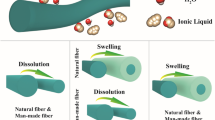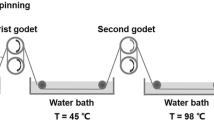Abstract
The swelling and dissolution mechanisms of dry, never-dried and re-wetted Lyocell fibers were investigated using mixtures of N-methylmorpholine N-oxide and water with various contents of water (from monohydrate to 24% w/w). A radial dissolution starting from the outer layers was observed. Dissolution kinetics was dependent on the water content, the drying state and the spinning conditions. A buckling of the core of dry fibers was observed during swelling. This phenomenon was attributed to the deformation of the unswollen core to accommodate the contraction of the swollen parts of the fiber. In purely swelling conditions with no dissolution, a huge swelling of a very thin skin layer was observed in the first stage, followed then by a progressive swelling of the inside of the fiber. We postulate that this mechanism arose from the fact that this skin is much less crystalline than the core.












Similar content being viewed by others
References
Abu-Rous M, Ingolic E, Schuster KC (2006) Visualisation of the fibrillar and pore morphology of cellulosic fibers applying transmission electron microscopy. Cellulose 13(4):411–419
Abu-Rous M, Varga K, Bechtold T, Schuster KC (2007) A new method to visualize and characterize the pore structure of tencel (lyocell) and other man made cellulosic fiber using a fluorescent dye molecule probe. J Appl Polym Sci 106:2083–2091
Biganska O, Navard P (2008) Morphology of cellulose objects regenerated from cellulose–N-methylmorpholine N-oxide–water solutions. Cellulose 16:179–188
Biganska O, Navard P, Bedue O (2002) Crystallisation of cellulose/N-methylmorpholine N-oxyde hydrates solutions. Polymer 43:6139–6145
Crawshaw J, Cameron RE (2000) A small X-ray scattering study of pore structure in Tencel cellulose fibers and the effects of physical treatments. Polymer 41:4691–4698
Cuissinat C, Navard P (2006) Swelling and dissolution of cellulose, part I: free floating cotton and wood fibers in N-methylmorpholine N-oxide water mixtures. Macromol Symp 244(1):1–18
Cuissinat C, Navard P (2007) Swelling and dissolution of cellulose, part III: plant fibers in aqueous systems. Cellulose 15:67–74
Ducos F, Biganska O, Schuster KC, Navard P (2006) Influence of the Lyocell fibers structure on their fibrillation. Cellul Chem Technol 40(5):299–311
Fang K, Hao L, Hu X, Shao H (2002) Fibrillation property of the Lyocell fibers treated by N-hydroxymethyl cross-linking agents. J Dong Hua Univ 19(4):24–28
Fang K, Hao L, Hu X, Shao H (2003) Ester crosslinking treatment for reducing the fibrillation tendency of Lyocell bifres. Tex Res J 73(11):1013–1016
Fink H-P, Weigel P, Purz H-J, Ganster J (2001) Structure formation of regenerated cellulose materials from NMMO solutions. Prog Polym Sci 26:1473–1524
Higgins HG, McKenzie AW (1963) The structure and properties of paper. XIV. Effects of drying on cellulose fibers and the problem of maintaining pulp strength. Appita 16(6):145–164
Jianchin Z, Meiwu S, Hua Z, Kan L (1999) Study of the skin–core structure of Lyocell staple fibers. Chem Fibers Int 49:494–500
Kato KL, Cameron RE (1999) A review of the relationship between thermally accelerated ageing of paper and hornification. Cellulose 6:23–40
Kongdee A, Bechtold T, Burtscher E, Scheinecker M (2004) The influence of wet/dry treatment on pore structure-the correlation of pore parameters, water retention and moisture regain values. Carbohydr Polym 57:39–44
Le Moigne N, Montes E, Pannetier C, Höfte H, Navard P (2008) Gradient in dissolution capacity of successively deposited cell wall layers in cotton fibers. Macromol Symp 262:65–71
Le Moigne N, Bikard J, Navard P (2010a) Rotation and contraction of native and regenerated cellulose fibers upon swelling and dissolution: the role of morphological and stress unbalances. Cellulose 17:507–519
Le Moigne N, Spinu M, Heinze T, Navard P (2010b) Restricted dissolution and derivatization capacities of cellulose fibers under uniaxial elongational stress. Polymer 51:447–453
Lenz J, Schurz J, Wrentschur E (1993) Properties and structure of solvent-spun and viscose-type fibers in the swollen state. Colloid Polym Sci 271(5):460–468
Mortimer SA, Peguy AA (1998) Methods for reducing the tendency of Lyocell fibers to fibrillate. J Appl Polym Sci 60:305–316
Nechwatal A, Nicolai M, Mieck KP, Heublein B, Kuhne G, Klemme D (1999) Studies on the wet fibrillation of Lyocell fibers. Angew Makromol Chem 271:84–92
Perepelkin KE (2007) Lyocell fibers based on direct dissolution of cellulose in N-methylmorpholine N-oxide: development and prospects. Fiber Chem 39:163–172
Rohrer C, Retzl P, Firgo H (2001) Lyocell LF-profile of a fibrillation-free fiber from Lenzing. Lenzinger Ber 80:75–81
Scallan AM (1998) Mechanisms of hornification. Proc. improvement of recyclability and the recycling paper industry of the Future, Blanco, Negro, Gaspar, Monte and Tijero (eds) COST Action E1, La Palmas de Gran Canaria, 24–26 Nov., pp 312–314
Schurz J, Lenz J (1994) Investigation of the structure of regenerated cellulose fibers. Macromol Symp 83:273–289
Schurz J, Lenz J, Wrentschur E (1995) Inner surface and void system of regenerated cellulose fibers. Angew Makromol Chem 229:175–184
Vickers ME, Briggs NP, Ibbett RN, Payne JJ, Smith SB (2001) Small angle X-ray scattering studies on lyocell cellulosic fibers: the effects of drying, re-wetting and changing coagulation temperature. Polymer 41:8241–8248
Warwicker JO, Jeffries R, Colbran RL, Robinson RN (1966) A review of the literature on the effect of caustic soda and other swelling agents on the fine structure of cotton. Shirley Institute Pamphlet 93, St Ann’s Press, England
Wooley JT (1975) Refractive index of soybean leaf cell walls. Plant Physiol 55:172–174
Acknowledgments
The authors gratefully acknowledge the financial support received from Lenzing AG, Austria, and their collaboration with Dr. C. Schuster.
Author information
Authors and Affiliations
Corresponding author
Additional information
C. Chaudemanche and P. Navard—Members of the European Polysaccharide Network of Excellence (EPNOE), www.epnoe.eu
Rights and permissions
About this article
Cite this article
Chaudemanche, C., Navard, P. Swelling and dissolution mechanisms of regenerated Lyocell cellulose fibers. Cellulose 18, 1–15 (2011). https://doi.org/10.1007/s10570-010-9460-4
Received:
Accepted:
Published:
Issue Date:
DOI: https://doi.org/10.1007/s10570-010-9460-4




